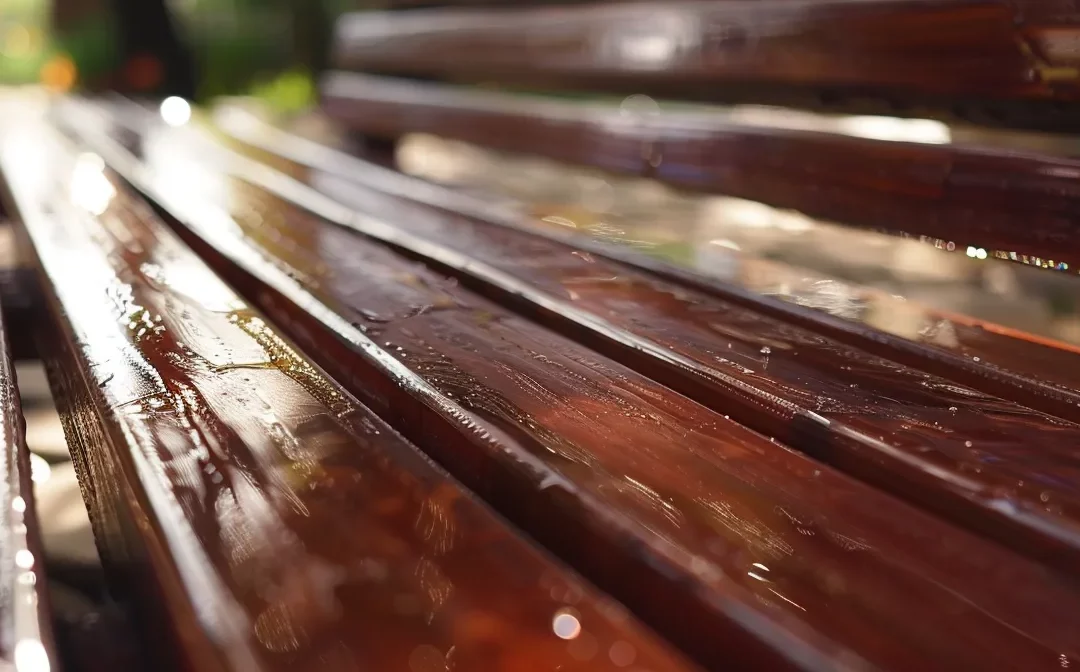Melbourne Bench Top Resurfacing And Repairs
Table Of Contents:
- Key Takeaways
- Understanding the Essentials of Benchtop Refinishing Materials
- Exploring Various Material Types for Refinishing
- Selecting the Right Material for Your Specific Needs
- Evaluating Environmental and Health Factors
- Gathering the Necessary Tools and Supplies
- Tips for a Successful Refinishing Project
- Conclusion
Are you looking to revitalize your kitchen or bathroom benchtops but unsure which materials offer the best results? Benchtop refinishing can transform your space, but choosing the right products—like wax, resin, epoxy, or oil—can be overwhelming. This guide will break down various refinishing materials and help you select the best fit for your project. You’ll learn how to evaluate the environmental impact, gather necessary tools, and execute a successful refinishing project. By the end, you’ll feel confident in making decisions that lead to beautiful and durable surfaces, addressing your concerns about quality and longevity.
Key Takeaways
- Assess your benchtop’s condition to choose suitable refinishing materials
- Selecting durable finishes enhances both aesthetics and functionality for high-use areas
- Prioritize low-VOC products for a healthier indoor environment during refinishing
- Proper preparation is essential for achieving optimal results in refinishing projects
- Regular maintenance protects your refinished surfaces from wear and extends their life
Understanding the Essentials of Benchtop Refinishing Materials

To effectively refinish your benchtop, start by assessing your Fimagine Website current countertop condition. This evaluation will guide you to determine suitable material options, including plastic or stone coat finishes. Next, consider the balance between cost and quality, focusing on critical factors like durability and chemical resistance. This approach will ensure you make informed, creative choices for your project.
Assessing Your Current Benchtop Condition
When assessing your current benchtop condition, start by inspecting for any signs of damage, such as chips, scratches, or water damage. Granite surfaces, while durable, are not immune to deterioration. Be sure to check if the finish is intact or if it has faded, as this can affect the longevity of the refinishing project.
Next, test for any stains or discoloration by applying a small amount of vinegar on different areas of the surface. If you notice an immediate reaction or the vinegar seeps into the stone, it may indicate the need for a primer to prepare the benchtop for refinishing. Understanding how well your benchtop stands up to basic household substances will help you choose the right finishing materials.
Lastly, evaluate the overall aesthetic appeal of your benchtop. Consider how it fits with your kitchen or bathroom design and whether it meets your personal style. Calculating the cost of materials against their durability and appearance ensures that you select the most suitable refinishing options, enhancing not only the look but also the function of your countertop.
Identifying Suitable Material Options
When selecting materials for benchtop refinishing, it’s important to consider how well they withstand wear and tear. Solid surface materials offer durability and are relatively resistant to scratches and stains. On the other hand, ceramic surfaces can provide an elegant look while being hygienic and resistant to bacteria, making them a great option for kitchens and bathrooms.
Butcher block is another popular choice, offering a warm, natural aesthetic. Though it might show signs of wear more quickly than other materials, regular maintenance can keep it looking fresh. Additionally, if you work in a home laboratory or similar spaces, choose finishes that can handle spills and resist chemicals, ensuring that your benchtop remains functional and vibrant over time.
Lastly, evaluate your personal style and the practical uses of the benchtop. If you prioritize aesthetics but need functionality, solid surface options provide a versatile canvas that can be customized to your preferred colors and designs. Always remember to match the material choice with the specific requirements of your space, balancing appearance with performance for the best results.
Balancing Cost and Quality
When it comes to refinishing your benchtop, balancing cost and quality is essential for achieving the best results. While it may be tempting to choose the cheapest materials available, investing in high-quality products will enhance the durability and appearance of your countertop. For example, opting for environmentally friendly finishes may cost a bit more upfront, but they often provide better long-term performance and require fewer chemicals, which benefits both you and the environment.
Consider the type of finish you want to apply. If you’re using a paintbrush for stain application, choose a product specifically designed for your benchtop material, whether it’s metal, wood, or stone. This careful selection will minimize issues like bubbling or peeling, ensuring a smooth and professional appearance that stands the test of time. Finding a balance means being willing to invest in proper tools and materials that suit your project.
It’s also crucial to take into account the maintenance required for different materials. Some finishes may appear stunning at first, but if they require excessive upkeep to maintain their look, the initial savings can quickly diminish. By selecting a durable option that can withstand wear on a daily basis, you ensure your benchtop remains functional and visually appealing in your kitchen or bathroom, making it an investment worth considering for both cost and quality in the long run.
You have grasped the essentials of benchtop refinishing materials. Now, let’s look closer at the different types you can choose from and how each can transform your space.
Exploring Various Material Types for Refinishing
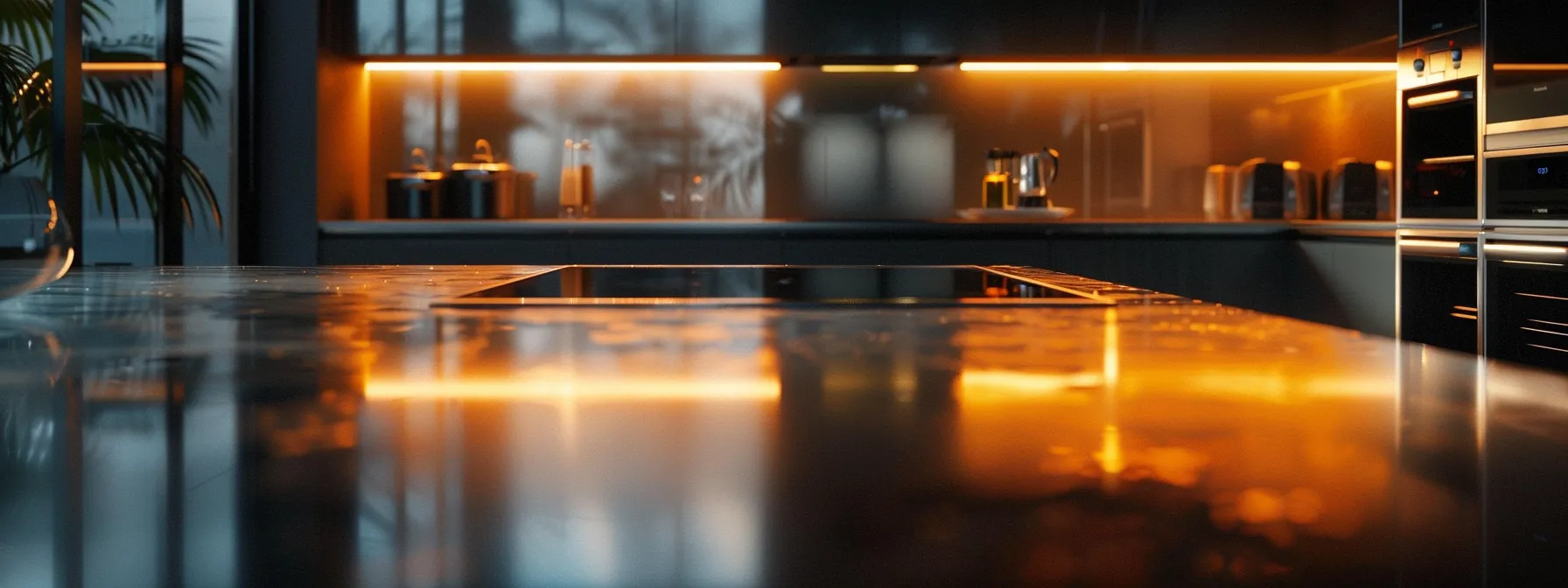
When refinishing your benchtop, consider the advantages of epoxy resin coatings for their durability and glossy finish. Acrylic refinishing kits offer user-friendly solutions with a quick drying time. Utilizing polyurethane finishes can enhance wood surfaces, while considering natural stone overlays provides a sophisticated touch, such as marble, enhancing your interior design. Each option has unique benefits to elevate your space.
Advantages of Epoxy Resin Coatings
One significant advantage of epoxy resin coatings is their exceptional durability. When applied correctly, they create a robust surface that can withstand everyday wear and tear in both kitchens and bathrooms. This makes them ideal for busy areas where scratches from sandpaper or daily usage are common, as they maintain their integrity and finish over time, enhancing your cabinetry and overall design.
Additionally, epoxy resin coatings offer a stunning, glossy finish that elevates the aesthetic appeal of your benchtops. The shine of epoxy can mimic the appearance of natural stone, such as quartz, without the hefty price tag. This allows you to achieve a high-end look for your project while still adhering to your budget, ensuring your refinished surfaces look polished and professional.
Application of epoxy is also user-friendly. You can easily apply it with a brush, allowing for a smooth and even coat. For the best results, proper preparation, including sanding the surface to create a suitable base, is essential. By investing time in preparation, you ensure that the epoxy adheres well, providing a long-lasting finish that you can be proud of in your home.
Benefits of Acrylic Refinishing Kits
Acrylic refinishing kits provide a user-friendly option for refreshing your benchtop without the need for replacing it entirely. These kits often come in a variety of colors and finishes, allowing you to match your countertop with your kitchen or bathroom décor while enhancing its aesthetic appeal. Using an acrylic kit can often be a more sustainable choice, as it promotes recycling by extending the life of your existing surfaces rather than discarding them.
Another advantage of acrylic refinishing kits is their superior hygiene standards. Acrylic finishes create a smooth, non-porous surface that is resistant to bacteria and mold growth, making them an ideal choice for busy kitchens and bathrooms. This characteristic provides peace of mind, knowing that your benchtop remains clean and safe for food preparation and other activities.
The liquid form of acrylic makes for easy application, whether you are a beginner or an experienced DIYer. The kits typically include all the necessary tools and detailed instructions, allowing you to achieve a professional-looking result without hiring a contractor. This convenience means you can take on your project confidently, saving both time and money while updating your space with a durable finish that stands the test of time:
Utilizing Polyurethane Finishes
Utilizing polyurethane finishes can significantly enhance the durability of your benchtop, whether you’re working with engineered stone, concrete, or steel. These finishes create a strong protective layer that shields your surfaces from scratches and stains, making them an ideal choice for high-traffic areas in your kitchen or bathroom. This level of protection ensures your countertop remains pristine after a makeover, minimizing the impact of daily wear and tear.
A major advantage of polyurethane is its versatility, allowing you to apply it to a variety of materials, including wood and engineered stone. This type of finish results in a clear, glossy surface that not only enhances the appearance of your benchtop but also makes cleaning easier. Regular dusting and wiping with a damp cloth will keep your surfaces looking new, ensuring that maintenance does not become a burden.
When applying polyurethane finishes, it’s crucial to prepare your benchtop properly to achieve the best results. This involves sanding the surface well to create a smooth base, enhancing adhesion. Adequate preparation and application will yield a clean and long-lasting finish, ensuring your kitchen or bathroom remains attractive and functional over time:
Considering Natural Stone Overlays
Considering natural stone overlays for your benchtop can significantly enhance both aesthetics and functionality in your kitchen or bathroom. These materials, such as granite or quartz, are known for their durability, resisting cracks and chips that often occur in high-use areas. When properly maintained, these surfaces can also withstand the etching that can be caused by acidic substances, ensuring your benchtop remains both beautiful and resilient over time.
Natural stone offers distinct advantages in terms of hygiene, as it can effectively resist bacteria common in kitchens, especially around sinks and food preparation areas. This characteristic keeps your kitchen cabinet surfaces safe and clean, providing peace of mind while cooking or handling food. Additionally, the non-porous variants of these stones prevent liquids from seeping into the surface, reducing the risk of stains and enhancing overall cleanliness.
Another notable benefit of natural stone overlays is their ability to elevate the appearance of your space. By choosing finishes that complement your kitchen cabinet design, you create a cohesive and stylish look. The natural beauty of stone adds a touch of elegance, making it ideal for those who wish to invest in a high-end appearance without the need for complete countertop replacement.
Now that you’ve seen the different materials used for refinishing, it’s time to focus on what fits your needs best. Choosing the right material is the key to ensuring lasting beauty and functionality in your space.
Selecting the Right Material for Your Specific Needs
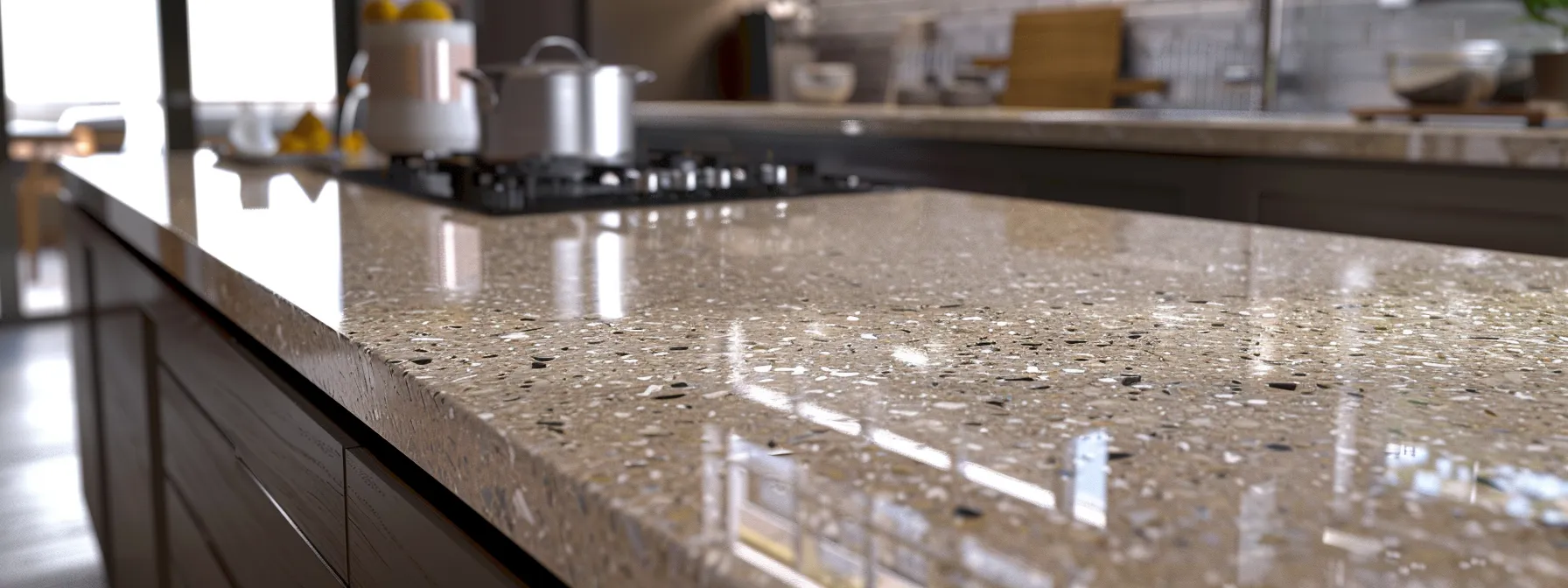
Matching materials to your kitchen or bathroom environments is key when selecting for benchtop refinishing. Consider the specific needs of high-use areas, prioritizing durability and easy maintenance. Additionally, opting for surfaces that provide heat and scratch resistance will ensure longevity. This section will explore the benefits of various materials, including mineral, tile, and silicon options that align with a minimalist aesthetic.
Matching Materials to Kitchen or Bathroom Environments
When selecting materials for your benchtop refinishing, consider how they fit into your kitchen or bathroom renovation. Durability is critical, especially in high-use areas. For instance, choosing soapstone offers excellent heat resistance and is easy to clean with just soap and water, ensuring it remains attractive and functional.
Adhesion is another essential factor. If you plan to use polyurethane finishes, ensure that the underlayment is properly prepared to create a strong bond. This preparation can include sanding the surface adequately to enhance adhesion, which will ultimately extend the longevity of your refinished countertop.
Each material has its strengths. For instance, while a solid surface material may provide a sleek look, soapstone may offer more resilience against scratches and heat. Evaluate your lifestyle and usage patterns to inform your decisions for a benchtop that meets your needs effectively:
Choosing Materials for High-Use Areas
When choosing materials for high-use areas, consider how well they can withstand wear and tear. Hardwood surfaces, while beautiful and warm, may require more maintenance to protect against scratches and moisture. By selecting hardwood finishes that emphasize grain patterns and are treated for added durability, you can ensure a lasting aesthetic appeal without sacrificing functionality.
Sustainability also plays a crucial role in material selection for high-traffic spaces. Opting for eco-friendly options not only contributes to a healthier environment but often results in more resilient surfaces. By understanding the impact of moisture on various materials, you ensure that your benchtop will perform optimally, no matter how frequently it is used.
Ultimately, the right material choice for high-use areas should balance aesthetics with practicality. A durable finish that resists wear will save you time and effort in the long run, allowing you to maintain your kitchens or bathrooms without constant upkeep. Investing in the right materials now can significantly enhance both your space and daily routine:
Opting for Heat and Scratch Resistance
When opting for materials that provide heat and scratch resistance, it’s crucial to consider how well they can handle everyday kitchen tasks. For instance, materials like travertine offer an appealing blend of beauty and durability, making them suitable for busy environments. By applying a high-quality sealant, you can enhance the resistance of your benchtop against both heat and abrasion, ensuring it maintains its visual appeal over time.
Choosing the right finish for your benchtop is essential, especially if you want to avoid unnecessary damage from everyday use. A surface that withstands heat and resists scratches will prevent wear and tear, ultimately extending the lifespan of your kitchen countertop. Remember, synthetic materials often outperform natural stones in terms of scratch resistance, but mixing materials can offer a unique aesthetic while maintaining functionality.
Lastly, making informed choices about materials can also have a positive impact on the environment. By selecting durable surfaces that withstand heat and scratches, you reduce the likelihood of needing replacements, which can lead to less waste in landfills. Investing in resilient materials ensures you enjoy a beautiful benchtop that meets your practical needs while being mindful of your ecological footprint.
Choosing the right materials sets the stage, but the choices don’t end there. Next, consider how these options impact your health and the environment, shaping a better future for your home and family.
Evaluating Environmental and Health Factors
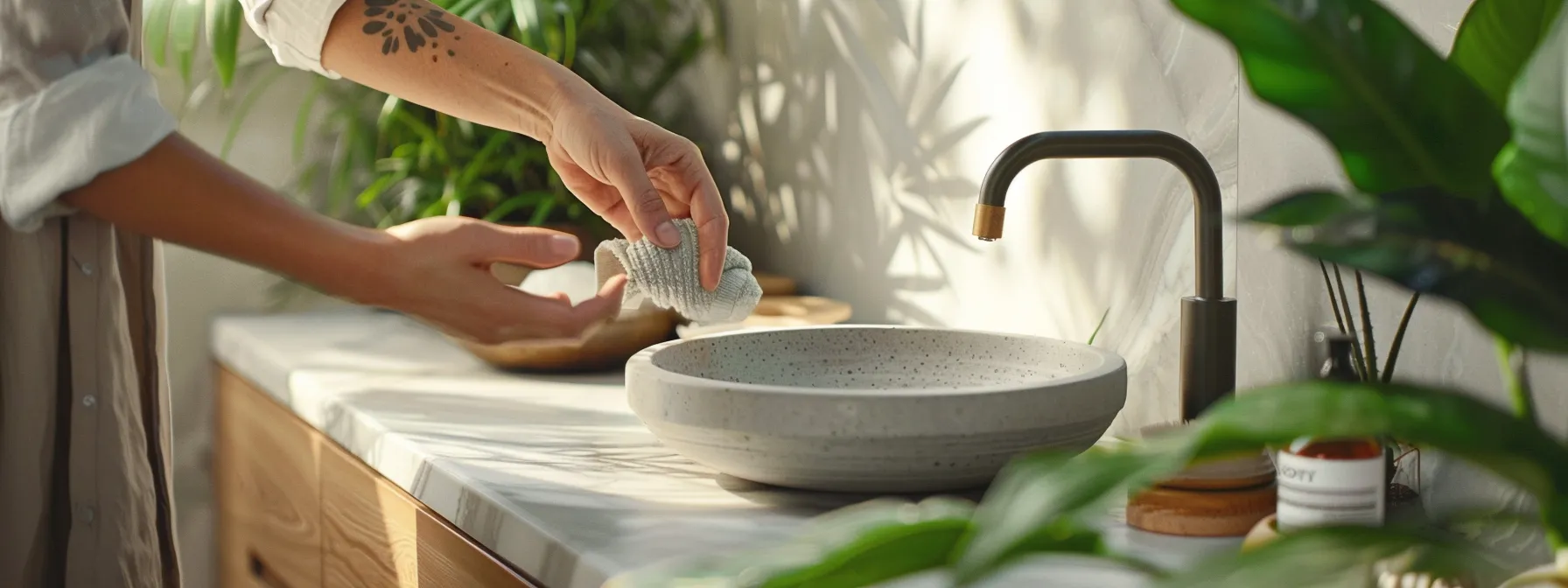
When evaluating materials for benchtop refinishing, focusing on low-emission options is vital for healthier indoor environments in your Bathrooms and Kitchens. Understanding VOCs in refinishing products will help you select safer choices, while opting for sustainable and eco-friendly materials contributes to responsible home improvement. These considerations will guide your decisions and ensure your refinishing project aligns with both safety and environmental goals.
Selecting Low-Emission Materials
When selecting materials for your benchtop refinishing, prioritizing low-emission options is essential for maintaining a healthy indoor environment. Look for products that are labeled as low-VOC (volatile organic compounds), as these materials emit fewer harmful chemicals into the air. This choice can significantly reduce potential health risks, ensuring a safer space for you and your family during and after the refinishing process.
Consider using water-based finishes and adhesives, which typically contain lower levels of VOCs compared to their solvent-based counterparts. These options not only improve air quality but also make cleanup easier, as water is the primary solvent. By opting for these environmentally friendly choices, you enhance the safety and functionality of your kitchen or bathroom without compromising on performance.
Additionally, researching the source of your materials can lead you to sustainable suppliers who emphasize eco-friendly practices. This commitment often translates to responsible manufacturing methods, further ensuring that the products you use are both safe and environmentally conscientious. Choosing low-emission materials reflects your dedication to health and sustainability, ultimately benefiting both your living space and the planet.
Understanding VOCs in Refinishing Products
Volatile Organic Compounds (VOCs) are chemicals found in many refinishing products, including paints, stains, and sealants. These compounds can evaporate into the air, potentially leading to indoor air quality issues, which may affect your health over time. Understanding the VOC levels in the products you choose is essential for creating a safe environment during and after your benchtop refinishing project.
When selecting materials, look for options labeled as low-VOC or no-VOC. These products emit significantly fewer harmful chemicals, reducing the risks associated with inhalation and exposure. You may notice that water-based finishes often have lower VOC levels compared to oil-based alternatives, making them a healthier choice for your kitchen or bathroom.
Not only do low-emission products enhance indoor air quality, but they also contribute to a more eco-friendly approach to refinishing. By choosing sustainable materials and finishes, you’re making a conscious decision that benefits both your home and the environment. This choice reflects your commitment to responsible home improvement practices and improves your space’s overall safety:
Choosing Sustainable and Eco-Friendly Options
Choosing sustainable and eco-friendly options for your benchtop refinishing project can significantly reduce your environmental impact. When selecting materials, look for those made from recycled content or sustainably sourced woods. These choices not only contribute to responsible home improvement but can also provide unique aesthetic appeal, ensuring your space stands out.
Using low-VOC products is another way to prioritize sustainability and health. Water-based finishes are often available with low volatile organic compound emissions, making them a safer choice for indoor air quality. This approach helps create a healthier environment for you and your family, minimizing exposure to harmful chemicals during and after the refinishing process.
Finally, consider the longevity of the materials you choose. Investing in durable options reduces the frequency of replacements, leading to less waste over time. By focusing on sustainable and eco-friendly solutions, you not only enhance the appearance of your benchtop but also support a cleaner, greener future for yourself and your community:
The air was thick with thoughts on health and the environment. Now, it was time to gather the right tools and supplies to bring new life to your space.
Gathering the Necessary Tools and Supplies
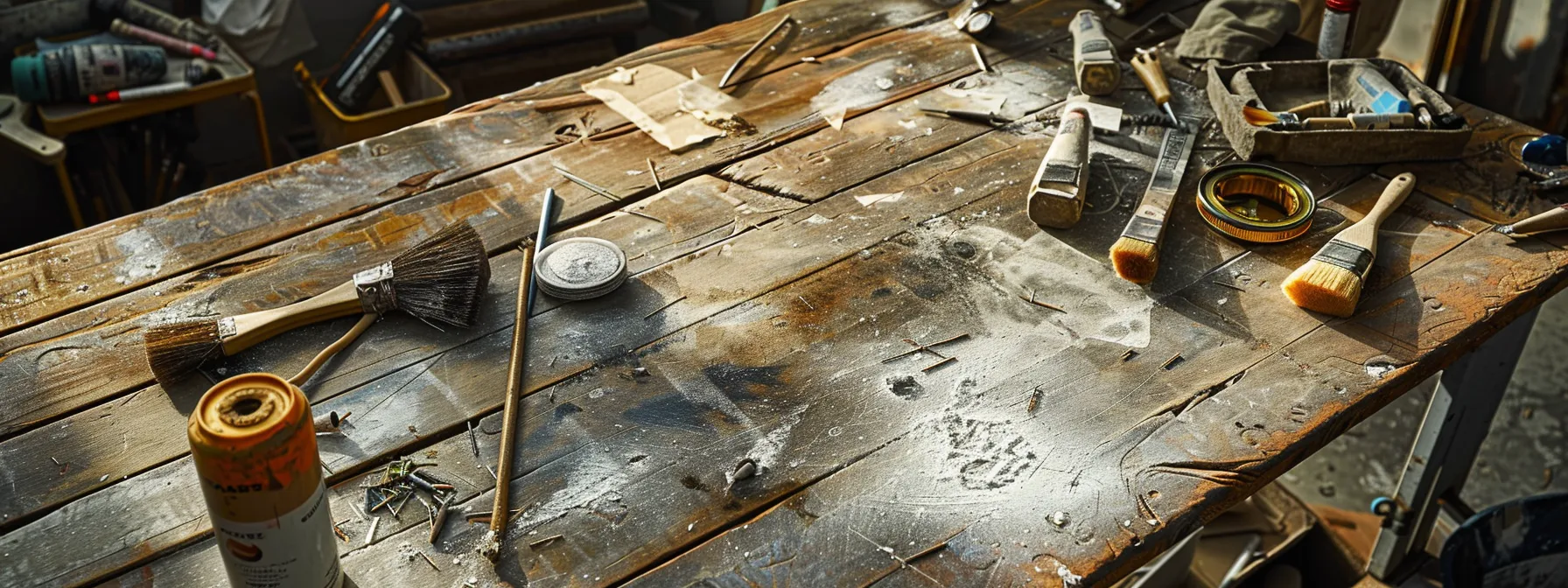
Gathering the necessary tools and supplies is crucial for a successful benchtop refinishing project. Begin by identifying essential tools that ensure a smooth application, such as brushes, sanders, and protective gear. Next, learn how to find quality materials at local and online retailers, allowing you to select the best options for your project. Finally, determine whether DIY kits or professional supplies better suit your needs and expertise, ensuring you achieve the desired results effectively.
Essential Tools for a Successful Refinishing Project
To kick off your benchtop refinishing project, ensure you have high-quality tools that simplify the process. A sturdy sander is essential for prepping your countertop by smoothing out imperfections and enhancing adhesion. Selecting either a hand sander or a powered sander will depend on the size and material of your benchtop, giving you control over the finish.
Brushes and rollers are necessities for applying your chosen finish evenly. Choose brushes specifically designed for the type of material you’re using; for instance, synthetic bristles work well with water-based finishes while natural bristles are best for oil-based products. Opting for a high-quality roller can also help in achieving a smooth, streak-free application, which is crucial for a professional look.
Lastly, don’t overlook the importance of protective gear. Safety glasses, gloves, and masks protect you from dust and fumes during the refinishing process. Ensuring your workspace is safe is just as important as selecting the right materials for your benchtop, as it allows you to work confidently and effectively while adhering to safety standards.
Finding Quality Materials at Local and Online Retailers
To find quality materials for your benchtop refinishing project, start by exploring local home improvement stores. These retailers often carry a wide selection of resurfacing products, including paints, coatings, and adhesives. You can consult with knowledgeable staff who can guide you in selecting materials that suit your specific needs and offer practical advice based on your project’s requirements.
Online retailers also present a convenient option for sourcing quality materials. Websites specializing in home improvement supplies often feature detailed product descriptions and user reviews, which can help you assess the value of different options. Before making a purchase, take advantage of the comparison features to ensure you’re getting the best materials for your budget and aesthetic preferences.
Additionally, consider checking out specialty shops that focus on resurfacing and restoration products. These suppliers often carry high-quality materials not typically found in larger retail chains. By diversifying your sourcing strategy, you position yourself to find the ideal products that will enhance the outcome of your benchtop refinishing project. Here’s a quick checklist to aid your search:
- Research local home improvement stores
- Visit online retailers for convenience
- Check specialty shops for unique materials
- Consult product reviews before purchasing
- Ask staff for recommendations
Comparing DIY Kits vs. Professional Supplies
When comparing DIY kits to professional supplies for your benchtop refinishing project, consider the level of control and customization each option offers. DIY kits often simplify the process, presenting all necessary materials in one package, making them accessible for those new to refinishing. However, while these kits are convenient, they may lack the flexibility and high-quality ingredients found in professional supplies, which can lead to superior results.
Professional supplies, on the other hand, typically allow you to select specific products tailored to your benchtop’s unique material and condition. This choice can lead to better adhesion and longevity for your refinished surfaces. If you have previous experience or are willing to learn, investing in professional materials often provides a more durable finish that enhances the overall look of your kitchen or bathroom.
Ultimately, your decision should align with your project goals and skill level. If you prioritize ease and a straightforward application, a DIY kit is a practical choice. Conversely, if you’re looking for long-lasting quality and are prepared to invest time and effort, using professional supplies will likely yield a more satisfying outcome. Here’s a checklist to guide your selection:
- Assess your skill level and experience with refinishing.
- Determine if you value convenience or customization.
- Research different brands to compare materials and reviews.
- Consider the specific needs of your benchtop material.
- Weigh the long-term benefits of professional supplies against the ease of DIY kits.
With tools in hand, you’re ready for action. Each step in your refinishing project matters, and a few smart tips can make all the difference.
Tips for a Successful Refinishing Project
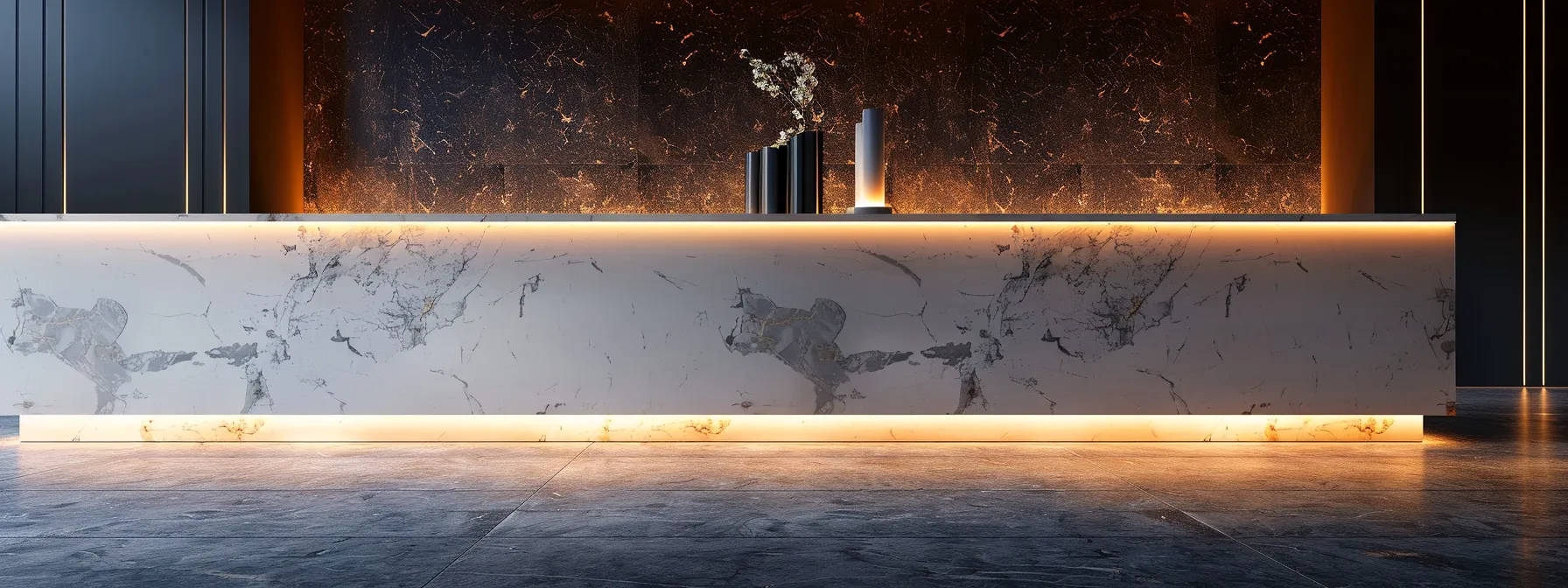
To achieve a successful benchtop refinishing project, focus on effectively preparing the surface to ensure proper adhesion. Applying materials correctly will lead to optimal results, while routine maintenance can extend the life of your refinished surfaces. You will also learn how to avoid common refinishing mistakes, enhancing your overall experience and outcome in this process.
Preparing the Surface Effectively
Preparing the surface is a vital step in the benchtop refinishing process. Start by cleaning the countertop thoroughly to remove any oils, dirt, or residues that could interfere with adhesion. You can use a mixture of warm water and a gentle cleaning solution, followed by a rinse and drying to ensure a clean base for the refinishing materials.
Once cleaned, inspect the surface for imperfections such as scratches, chips, or stains, which may need addressing before applying any refinishing products. Sanding plays a critical role here; using sandpaper or a sander helps smooth uneven areas and creates a rough texture that encourages better adhesion. Ensure you wear protective gear to avoid inhaling dust particles during this process.
After sanding, wipe down the surface with a damp cloth to eliminate any dust particles that could compromise the finish. Following this thorough preparation will significantly enhance the longevity and appearance of your refinished benchtop, making it essential for achieving the best results from your chosen materials.
Applying Materials for Optimal Results
To achieve optimal results in your benchtop refinishing project, start by selecting the right application technique for your chosen material. For example, when using epoxy resin, applying it with a brush allows for an even coating that helps avoid bubbles or uneven surfaces. Ensure you follow the manufacturer’s instructions for mixing and curing times, as this will greatly influence the final look and longevity of your refinished surface.
It’s essential to work in a well-ventilated area when applying refinishing products, especially those with strong odors or chemicals. Proper ventilation not only ensures your safety but also promotes better drying times, resulting in a more durable finish. Take your time during this process; rushing can lead to mistakes that compromise the quality of your work, leaving you dissatisfied with the end result.
Once you’ve applied your chosen materials, be patient as they cure properly. This step is crucial in ensuring the bond between the material and the benchtop is strong, providing the durability you expect from your refinishing project. Regular maintenance after the application, such as gentle cleaning and avoiding harsh chemicals, will help preserve that fresh look, keeping your countertops both beautiful and functional for years to come.
Ensuring Longevity With Proper Maintenance
To ensure the longevity of your refinished benchtop, establish a consistent maintenance routine. Regularly cleaning the surface with a mild detergent and soft cloth prevents buildup of dirt and grime, which can cause scratches and dullness over time. Avoid harsh chemicals, as they may damage the finish and compromise the protective layers of the materials used.
Another important aspect of maintaining your benchtop is to address any spills or stains immediately. Quickly wiping up substances like oils, sauces, and liquids will prevent them from setting into the material, which can lead to discoloration or more significant damage. This proactive approach allows you to keep the surface looking fresh and preserves the aesthetic appeal of the refinishing.
Lastly, consider periodic inspections of the surface for signs of wear, such as scratches or fading. If you notice any issues, take prompt action by applying a touch-up coat or using a rejuvenating product designed for your specific benchtop material. This attention to detail ensures your refinished surface remains functional and visually appealing, enhancing the overall experience in your kitchen or bathroom.
Avoiding Common Refinishing Mistakes
Avoiding common refinishing mistakes is essential to achieving a professional-looking result. One frequent error is neglecting surface preparation. You must clean and sand the benchtop thoroughly before applying any materials to ensure proper adhesion. Skipping this step can lead to peeling or bubbling finishes, undermining the durability of your refinishing project.
Another common mistake is using the wrong application technique for your chosen materials. Each finish, such as epoxy or acrylic, requires specific methods for optimal results. Following the manufacturer’s instructions closely can prevent issues like uneven surfaces or extended drying times. Patience during this stage pays off by ensuring a flawless finish.
Lastly, forgetting to use protective gear can result in health risks and impair your refinishing experience. Always wear safety glasses, gloves, and masks to safeguard yourself from dust and fumes. By taking these precautions and learning from others’ mistakes, you can create a beautiful, long-lasting benchtop that enhances your kitchen or bathroom space:
- Ensure thorough surface preparation.
- Follow application techniques specific to your chosen materials.
- Use protective gear to maintain health and safety.
Conclusion
Choosing the right materials for benchtop refinishing is crucial for achieving a durable and aesthetically pleasing surface. By assessing your current benchtop condition and matching materials to your specific needs, you can enhance both functionality and style in your kitchen or bathroom. Prioritize low-emission and eco-friendly options to promote a healthier indoor environment while enjoying beautiful finishes. Ultimately, informed decisions lead to successful refinishing projects that stand the test of time, making your investment worthwhile.
